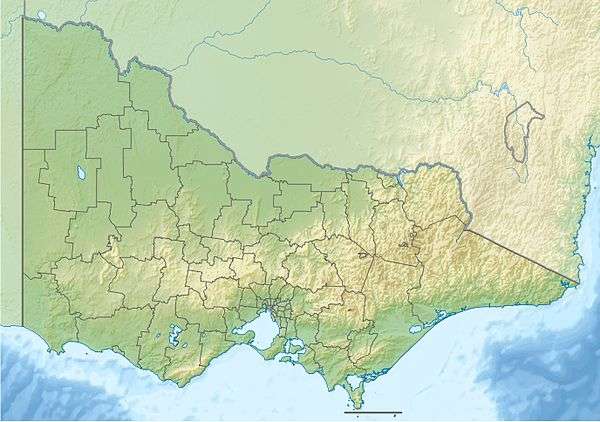Waranga Dam
The Waranga Dam is a major earthfill embankment dam with an uncontrolled spillway located approximately 150 kilometres (93 mi) north of Melbourne in the North Central region of the Australian state of Victoria. The impounded off-stream reservoir is Waranga Basin and forms part of the Goulburn River irrigation system, irrigating an area of 626 square kilometres (242 sq mi).[1] The dam and reservoir are located in Shire of Campaspe near the City of Greater Shepparton and is located 8 kilometres (5.0 mi) northeast of Rushworth, 12 kilometres (7.5 mi) southwest of Tatura, and near Murchison. When full, the reservoir covers an area of 58.5 square kilometres (22.6 sq mi).
| Waranga Dam | |
|---|---|
 Location of the Waranga Dam in Victoria | |
| Country | Australia |
| Location | North Central region, Victoria |
| Coordinates | 36°33′S 145°06′E |
| Purpose | Irrigation |
| Status | Operational |
| Construction began | 1905 |
| Opening date | 1915; 1926 |
| Owner(s) | Goulburn–Murray Water |
| Dam and spillways | |
| Type of dam | Embankment dam |
| Impounds | Off-stream |
| Height (foundation) | 12.2 m (40 ft) |
| Length | 7 km (4.3 mi) |
| Dam volume | 58,480×103 m3 (2,065×106 cu ft) |
| Reservoir | |
| Creates | Waranga Basin (official) |
| Total capacity | 432,360 ML (9.511×1010 imp gal; 1.1422×1011 US gal) |
| Surface area | 58.5 km2 (22.6 sq mi) |
| Website www | |
| [1] | |
The area now covered by the Waranga Basin includes a swamp that was known as Warranga (an indigenous word) or Gunn's after one of the early pastoralists who established his squatting run, also called Waranga, in the area surrounding the swamp. Gold was discovered near Waranga Swamp in 1853, making it one of Victoria's oldest goldfields.[2]
Construction
Construction of the earth dam began in 1905 and was completed in 1915 using picks, shovels and horse-drawn scoops. The site of the basin was a former swamp in the then Waranga Shire. Construction of the dam was commissioned by the State Rivers and Water Supply Commission of Victoria for the irrigation of the Western Goulburn Valley. At the time of construction, the Waranga Basin embankment was described as the largest project of its sort in the world with an embankment height of 8.8 metres (29 ft) and length of 7 kilometres (4.3 mi).[1]
Between 1915 and 1926, the embankment was raised in stages and a core wall was inserted. By 1921, the embankment was raised to 12.2 metres (40 ft) allowing the storage capacity to be increased to 432,360 ML (9.511×1010 imp gal; 1.1422×1011 US gal), its current capacity.[3] The major road between Tatura and Rushworth crosses the outlet.
Distribution of the water
Waranga Basin stores water flowing downstream from Lake Eildon as well as having a catchment area of its own. Waranga Basin supplies water to the Central Goulburn Irrigation Area and Rochester Irrigation Area. However, the Waranga Western Channel takes some of the water 180 kilometres (110 mi) to Pyramid Hill and Boort. Goulburn–Murray Water is responsible for regulating the flow of water from the basin.
Normally, only about three-quarters of the 432,360 ML (9.511×1010 imp gal; 1.1422×1011 US gal) can be used in irrigation. However, in 2002-03, an additional 90,000 megalitres (20×109 imp gal; 24×109 US gal) was supplied through pumping to assist farmers in the Goulburn Irrigation System experiencing severe drought.
References
- "Register of Large Dams in Australia" (Excel (requires download)). Dams information. Australian National Committee on Large Dams. 2010. Retrieved 20 October 2014.
- "RUSHWORTH - WARANGA NORTH MINING DIVISION" (PDF) (PDF). Victorian Government. Retrieved 13 August 2009.
- "Waranga Basin: Recreation Guide" (PDF) (PDF). Goulburn–Murray Water. February 2012. Retrieved 20 October 2014.